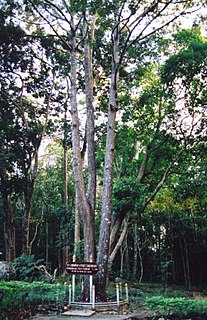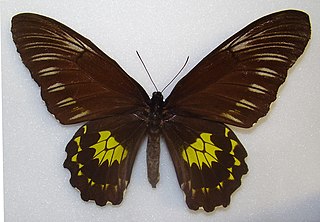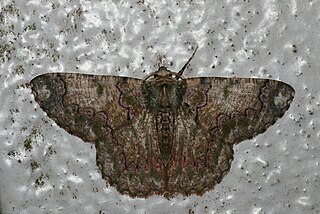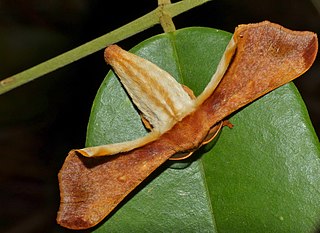
Attacus atlas, the Atlas moth, is a large saturniid moth endemic to the forests of Asia. The species was first described by Carl Linnaeus in his 1758 10th edition of Systema Naturae.

Shorea is a genus of about 196 species of mainly rainforest trees in the family Dipterocarpaceae. The genus is named after Sir John Shore, the governor-general of the British East India Company, 1793–1798. The timber of trees of the genus is sold under the common names lauan, luan, lawaan, meranti, seraya, balau, bangkirai, and Philippine mahogany.

The Pyraloidea are a moth superfamily containing about 16,000 described species worldwide, and probably at least as many more remain to be described. They are generally fairly small moths, and as such, they have been traditionally associated with the paraphyletic Microlepidoptera.

The Limacodidae or Eucleidae are a family of moths in the superfamily Zygaenoidea or the Cossoidea; the placement is in dispute. They are often called slug moths because their caterpillars bear a distinct resemblance to slugs. They are also called cup moths because of the shape of their cocoons.

Troides miranda, the Miranda birdwing, is a birdwing butterfly that inhabits Borneo and Sumatra.

Troides andromache, the Borneo birdwing , is a species of butterfly in the family Papilionidae. It is found only in Borneo.
Paranagia is a monotypic moth genus in the family Erebidae erected by George Hampson in 1926. Its only species, Paranagia rufostrigata, was first described by George Thomas Bethune-Baker in 1906. It is found on New Guinea and on the southern Maluku Islands, Sulawesi and Borneo. The habitat consists of forests and areas with secondary vegetation.
Scopula pauperata is a moth of the family Geometridae. It is found on Borneo. The habitat consists of lowland forests.
Zythos obliterata is a moth of the family Geometridae described by William Warren in 1897. It is found on Borneo, Peninsular Malaysia and Sumatra. The habitat consists of lowland alluvial forests, secondary forests and dry heath forests.

Lophophelma vigens is a moth of the family Geometridae first described by Arthur Gardiner Butler in 1880. It is found in the Himalayas and on Peninsular Malaysia, Sumatra and Borneo. The habitat consists of lower and upper montane forests.
Asura calamaria is a moth of the family Erebidae first described by Frederic Moore in 1888. It is found in from the north-eastern Himalayas to Sundaland, including Myanmar. The habitat consists of disturbed forests, including disturbed alluvial forests and remnants of primary montane forests.

Barsine perpusilla is a species of moth of the family Erebidae, subfamily Arctiinae. It is found on Borneo and Sumatra. The habitat consists of dipterocarp forests and lower montane forests.

Didiguides is a monotypic moth genus of the family Nolidae erected by Lutz W. R. Kobes in 1994. Its only species, Didiguides semifervens, was first described by Francis Walker in 1863. It is found on Borneo, Sumatra and Sulawesi, as well as in New Guinea and on the Bismarck Islands. The habitat consists of dipterocarp forests, including alluvial forests.
Netechma cuneifera is a species of moth of the family Tortricidae. It is endemic to Ecuador.
Holocraspedon bilineata is a moth of the family Erebidae first described by George Hampson in 1901. It is found in Singapore, Thailand and the north-eastern Himalayas, as well as on Peninsular Malaysia, Borneo, Sulawesi and Sumbawa. The habitat consists of lowland forests and wet heath forests.
Lyclene pudibunda is a moth of the subfamily Arctiinae. It was described by Pieter Cornelius Tobias Snellen in 1880. It is found on Sumatra and Borneo and in the north-eastern Himalayas. It is found in a wide range of habitats, including secondary vegetation, dipterocarp forests and heath forests in the lowlands, as well as lower montane forests.
Manoba melanomedia is a moth in the family Nolidae. It was described by Hiroshi Inoue in 1991. It is found on Borneo and in Taiwan and Thailand. The habitat consists of hill dipterocarp forests and lower montane forests and scrub on limestone.

Manoba tesselata is a moth in the family Nolidae. It was described by George Hampson in 1896. It is found in Taiwan, as well as on Borneo, Sumatra, Java, Bali, Seram and the north-eastern Himalayas and in Thailand. The habitat consists of montane forests.

Gunda ochracea is a species of moth in the family Bombycidae. It was described by Francis Walker in 1862. It is found in the Indian subregion and from South-east Asia to Sumatra, Borneo and the Philippines. The habitat consists of various lowland forest types.
Groenendaelia is a monotypic moth genus in the family Cossidae. Its only species, Groenendaelia kinabaluensis, is found in Sundaland, including Borneo. The habitat consists of montane forests and lowland areas.










